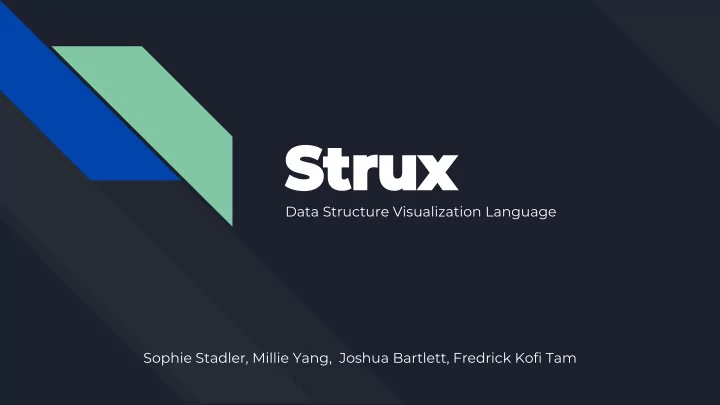

Strux Data Structure Visualization Language Sophie Stadler, Millie Yang, Joshua Bartlett, Fredrick Kofi Tam
Strux ● Strux is a general-purpose language that allows for the visualization of data structures ● Using a familiar Java-like syntax, it helps programmers become familiar with the different ways data is stored ● Easy to use: data structures are built in
Motivation Learning data structures is difficult Visualizations It can be hard to relate code to ASCII art rendering of a stack, ● ● data structure concepts queue, linked list, binary tree, or Textbook drawings of data array ● structures are static Dynamic ● Difficult to see how they Help programmers: ○ ● relate to code after each Become familiar with the key ○ operation features of each structure Expose the data their objects ○ Solution: Visualizations currently contain
Features Strux Specialties Built-in data structures ● Array ○ Tree ○ Stack ○ Standard Language Elements Queue ○ LinkedList Strictly typed ○ ● Operators ● .show() ● Data structures are printed in ASCII Increment and decrement ○ ○ Control flow format ● Quick Sort arrays: step-by-step visualization if/elif/else ● ○ Loops Unified function calls for data structures ● ○ enqueue / push → add() Statements ○ ○ Program entry point: main() dequeue / pop → remove() ○ ● quicksort() /tree can take in num [] , Must return int ○ ○ string[], or int []
Software Technologies Used GitHub LLVM OCaml Ubuntu Atom C DigitalOcean
Architecture
AST
Running Strux $ make $ ./linkStrux.sh $ ./testall.sh
Running Strux linkStrux.sh Stack, Queue, LinkedList, Tree, showQuickSort written in C ● linkStrux.sh converts C to bytecode ● testall.sh MicroC test script ● Runs all .strux files in tests/ directory and compares output to ● .out or .err file
Test Edge Cases ● Visualization of large numbers or large data structures ○ Calling methods on empty data structures ○ Handling null exceptions ○ Incompatible Types ● Initialization, typos ○ Static vs. dynamic scoping ● Pass by value vs. by reference ● Duplicate initialization ● Calling methods that do not exist ●
Test - Unit and Integration Tests Unit Test Integration Test int main() { int main() { print(gcd(81, 153)); int i = 2; return 0; print(i--); } return 0; } int gcd(int n1, int n2) { int gcd = 1; for (int i = 1; i <= n1 and i <= n2; i++) { if (n1 % i == 0 and n2 % i == 0) { gcd = i; } } return gcd; }
Test - Incompatible Types/Error Checks Fail Test: int main() { LinkedList::string l = new LinkedList::string(); l.add(3); return 0; } Terminates Gracefully: Fatal error: exception Failure("illegal actual add argument found int expected string in 3")
Stack Console Output +---+ <- Top | 4 | +---+ int main() { | 3 | Stack::int s = new Stack::int(2,3,4); +---+ s.show(); | 2 | +---+ <- Top +---+ | 3 | s.remove(); +---+ s.show(); | 2 | +---+ s.add(5); +---+ <- Top | 5 | s.show(); +---+ return 0; | 3 | } +---+ | 2 | +---+
Queue int main() { Queue::string struxers = new Queue::string("Josh", "Kofi", "Millie", "Sophie"); struxers.show(); +------+------+--------+--------+ | Josh | Kofi | Millie | Sophie | struxers.add("Edwards"); +------+------+--------+--------+ struxers.show(); Head Tail struxers.remove(); struxers.show(); } +------+--------+--------+---------+ +------+------+--------+--------+---------+ | Kofi | Millie | Sophie | Edwards | | Josh | Kofi | Millie | Sophie | Edwards | +------+--------+--------+---------+ +------+------+--------+--------+---------+ Head Tail Head Tail
LinkedList int main() { LinkedList::num ll = new LinkedList::num(8.6, 6.0); ll.show(); ll.delete(1); ll.show(); } +----------+ +----------+ +------+ +----------+ +------+ | 8.600000 |->| 6.000000 |->| NULL | | 8.600000 |->| NULL | +----------+ +----------+ +------+ +----------+ +------+ 0 1 <- Index 0 <- Index
Array and Quick Sort int main() { int[4] myArr = [0, 1, 2, 3]; myArr.show(); myArr[2] = 8; myArr.show(); } [0, 1, 2, 3] [0, 1, 8, 3]
Array and Quick Sort int main() { int[9] myArr = [1, 4, 3, 6, 7, 2, 99, 23, 37]; myArr.quickSort(); myArr.show(); num[9] a = [1.2, 4.4, 3.5, 6.5, 7.5, 2.3, 23.9, 99.5, 37.9]; a.quickSort(); a.show(); } [1, 2, 3, 4, 6, 7, 23, 37, 99] [1.200000, 2.300000, 3.500000, 4.400000, 6.500000, 7.500000, 23.900000, 37.900000, 99.500000]
Array and Quick Sort ================================================= At this step: current array: [3 4 1 6 ] int main() { numbers swapped: 1,4 int[4] myArr = [3, 4, 1, 6]; array after swap: [3 1 4 6 ] myArr.showQuickSort(); pivot is 4 } ================================================= At this step: current array: [3 1 4 6 ] pivot swapped: 3,1 array after swap: [1 3 4 6 ] pivot is 3 ================================================= At this step: current array: [1 3 4 6 ] pivot is 1 ================================================= QuickSort complete! Final Result: [1 3 4 6 ]
BSTree int main() { (0001) BSTree::int tree = new BSTree::int(); *----*------* tree.add(1); (0000) (0002) tree.add(2); *-----------------* *------* tree.add(3); (-004) (0003) tree.add(0); *------------* tree.add(-4); (-002) tree.add(-2); *-----* tree.add(-3); (-003) tree.show(); return 0; }
Limitations of ASCII Challenges Very large data structures appear ● distorted when show() is called due to the macOS High Sierra way they are printed For LinkedList and Queue , we introduce ● On the new macOS, some previous ● compact visualizations when structures architectural systems are not being are too long supported LLVM.Bitreader would throw a ○ LinkedList bitreader error +---+ +---+ +------+ Because we need to translate our C ● | 0 |->| 1 |->| NULL | vs. [0]->[1]->[NULL] code into bitcode, we decided to +---+ +---+ +------+ 0 1 develop on an Ubuntu instance hosted on DigitalOcean to introduce a level of Queue abstraction and make it easier for +---+---+---+ members on the team with High Sierra | 0 | 1 | 2 | vs. Head->[0][1][2]<-Tail Older macOS systems still work ● +---+---+---+ perfectly with Strux code Head Tail
NOW TIME FOR THE DEMO!
Recommend
More recommend